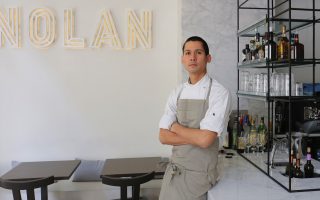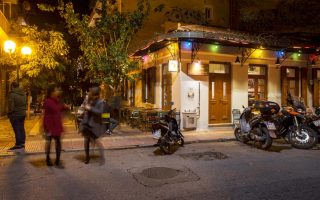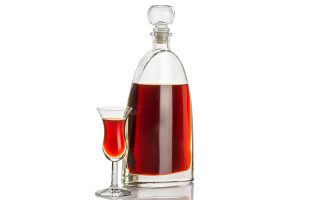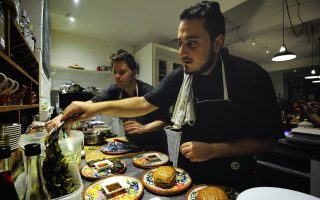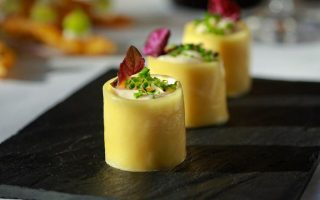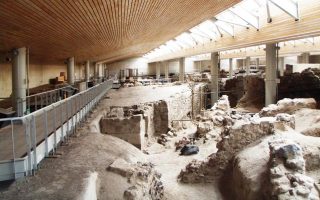A monk shares his love of God, food and wine
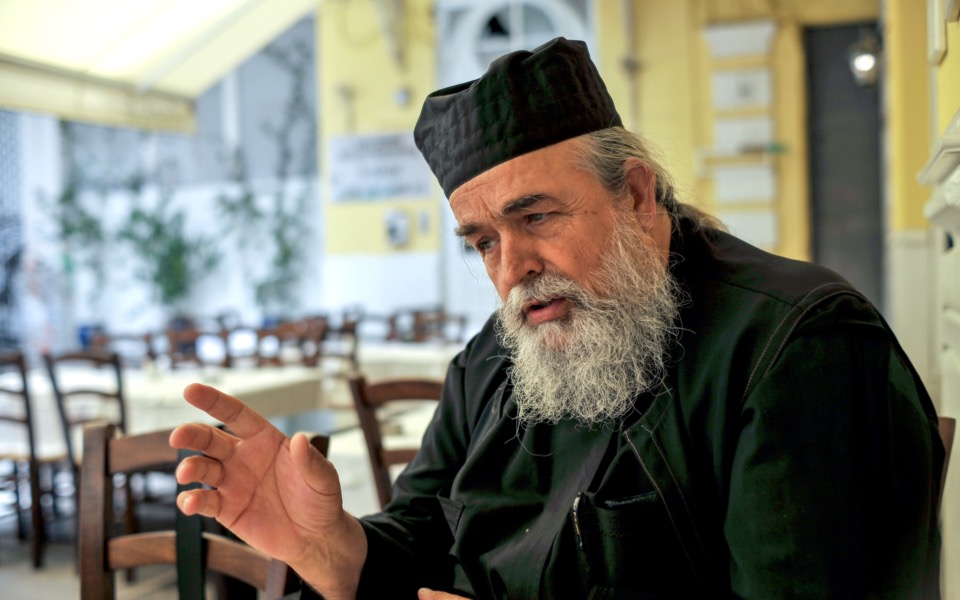
Father Epiphanios is one of the better-known monks of the monastic community of Mount Athos in northern Greece. A dedicated winemaker with exports from his vineyard at the Skete (monastic settlement) of Timios Prodromos Iviron – a part of Mylopotamos, a dependency of the Holy Monastery of Megiste Lavra – traveling all over Greece and Europe, he is also an excellent cook with international distinctions and the foremost ambassador of the monastery’s cuisine and dietary habits overseas.
Epiphanios has gladdened hearts and stomachs in France, Italy, Britain, Spain, Germany and elsewhere. He has been invited to cook in the kitchens of eminent chefs, while his book “The Cuisine of the Holy Mountain Athos,” has been translated into seven languages. During the annual commemoration of the Dormition of the Virgin Mary on August 15, he cooks 2.5 tons of fish, feeding around 4,000 mouths.
“Epi,” as he’s known by his many friends, is open-minded, well-traveled and dedicated to God. He’s an expert at the winery and in the kitchen, and an absolutely delightful conversationalist.
We met in a taverna in Thessaloniki and had lunch while discussing his life and work.
Epiphanios was born in the small village of Nikisiani in Kavala, northern Greece. His father had a vineyard of a half a hectare in an area that has been renowned for wine production since ancient times.
“The people were real merrymakers. They enjoyed life and drank a lot of wine and tsipouro. The had a lot of festivals dedicated to wine. Their days off from work were spent eating and drinking,” he says.
These were the early influences that led to him being regarded as a top chef and winemaker at Athos. “It’s all a matter of having experience in and love for what you do,” he says.
He produced his first vintage from the vineyard of Mylopotamos in 1997, a merlot, with the help of an Italian oenologist. Today, the winery exports seven different labels.
“If you don’t love your vineyard, it’s a complete hassle. If you do, it’s majestic.”
What brought you to Mount Athos?
Becoming a monk is not a simple matter. To be captivated by the love of God you need to be uplifted, to be summoned by God, if you may. And you need to have an inclination to God.
What is a regular day like for a monk?
A monk’s primary deed is prayer and studying the Scriptures. These two lift us and bring us closer to ascension. Union with God is the monk’s aim. Monks dedicate about four-and-a-half hours to prayer every day at communal monasteries, six hours on Sundays and holidays and 15 hours at Christmas.
Is it true that monks try to convert young people?
That’s ridiculous. Sure, they may come here of their own free will and then regret it and leave, but it’s not something you can force on people.
As a community, do you feel threatened by secularism?
No. I’m not concerned by a monk owning a car, a jeep or a cell phone. I am concerned about young people who become monks when they are carrying a lot of negative baggage that they can’t get rid off.
Doesn’t the fact that you can get caviar and expensive whisky at Karyes, the Athonite community’s secular administrative center, not tell you anything?
Nothing at all. Lay people drink and buy such things. Don’t forget that Mount Athos had three banks, two Greek and a French one, in the inter-war years. There also used to be butcher shops.
Do the monks eat meat?
The lay people eat it. Athos has 2,000 monks and as many people coming in every day as laborers or pilgrims. Now, if 30 monks among the 2,000 do eat meat, that is not a stain on Christianity.
How do you cope with so many visitors?
I wouldn’t call it hospitality anymore; it’s an invasion. We get more than 200,000 visitors a year. A single monastery may have 40-50 monks and 100-150 visitors a day. This needs to stop. Sure, it’s tempting because everything on Mount Athos is free. Visitors pay 25 euros for an entry pass and the fare for the ferry boat and then spend five days here without having to pay for food, drink or anything.
Charge 20 euros and you’ll see how fast we’ll separate the wheat from the chaff.
We have people who come here out of interest or love for the community, out of spiritual motivation, and others who are just here for the ride.
Restoring a historic Byzantine dependency and its vineyard
Father Epiphanios’s cell is in a Byzantine tower on the rocky east coast of Athos and has a view of the islands of Thasos and Limnos. He is welcomed every morning by the sun rising slowly over the northeastern Aegean. At night, the sea swells and the waves crash onto the rocks below the tower.
Epiphanios put a lot of work into the project of restoring the wonderful Byzantine complex of Mylopotamos. He came to Mount Athos in 1990, after spending a year at the Monastery of Saint Catherine in Sinai. The Mylopotamos dependency was a burned, ruined edifice and he has helped bring it back to life in every respect.
Epiphanios acquired lifetime ownership of Mylopotamos from the Holy Monastery of Megiste Lavra for 2 million drachmas, or roughly 6,000 euros. It allows him to build on the site, but he is also responsible for maintaining and restoring it.
The vineyard that yields the marvelous Mylopotamos wines surrounds the complex and boasts a state-of-the-art winery. The dependency also has an impressive library, with 4,000 ecclesiastical books, manuscripts and works by modern writers and historians.
It comes as little surprise – especially given the personality of Epiphanios himself – that Mylopotamos is particularly popular with visitors, among them Greek and international VIPs – though he won’t drop any names.
When Epiphanios produced the first bottles of wine in the 1990s, he was lambasted by the other monks, who accused him of being a capitalist.
Are there any other winemakers on Athos?
There are now 10 wineries. Three or four make good wines – Vatopedi, Simonopetra, Monoxilitis, Aghios Pavlos…
How do you get along? Is there a lot of competition?
What competition… I honestly feel some satisfaction in being vindicated now from something I was accused of… It’s a small dose of revenge.
Is there any truth to the stories that the monks of Mount Athos live a long time and that certain diseases are unknown in the community because of the diet?
You could call our diet Mediterranean in one sense, but it has two additional advantages: We alternate between lenten and non-lenten foods. There are days when we eat only vegetables, pulses or olives. On the other days we eat fish. For about 150 days in the year, the monks eat food without any oil. This allows the liver and pancreas – the entire body – to have a rest. Diseases that are associated with diet are rare on Mount Athos. We rarely, for example, see intestinal or stomach cancer. But it’s also the way of life in general that helps. We have no stress and so we see little in the way of heart disease, strokes and so on.
Who taught you to cook?
Like all things in life, in cooking either you have it or you don’t. Once you have it, you elevate it, perfect it with the help of a good teacher. I used to watch my mother cook as a child, observe how she made mince patties. It’s all about experience.
Do you ever regret becoming a monk?
No. Never. I became a monk at 18. My 43 years at Mount Athos have filled my soul with creativity, knowledge, acquaintances, travels and public relations. When I had a serious health problem last year, I really felt that I was ready to go. My soul was sated.
